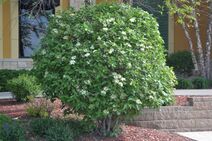Viburnum lantana
| Viburnum lantana | |
 | |
| Light: | |
| Moisture: | |
| Hardiness: | 3 |
| Soil pH: | 5.6-8.4 |
| Self Pollinated | |
| Height: | 16' |
| Width: | 13' |
| Speed: | Moderate |
| Blooms: | Late Spring-Early Summer |
| Open Woods Forest | |
| Native to: | |
| Edible Rating: | |
| Tea: | Yes |
Viburnum lantana (common name: wayfaring tree) is a shrub with white flowers. In the wild it is a good indicator plant of soil high in calcium carbonate.[1]
Propagation: Seed - best sown in a cold frame as soon as it is ripe. Germination can be slow, sometimes taking more than 18 months. If the seed is harvested 'green' (when it has fully developed but before it has fully ripened) and sown immediately in a cold frame, it should germinate in the spring[2]. Stored seed will require 2 months warm then 3 months cold stratification and can still take 18 months to germinate[3]. Prick out the seedlings into individual pots when they are large enough to handle and grow them on in a cold frame or greenhouse. Plant out into their permanent positions in late spring or early summer of the following year.
Cuttings of soft-wood, early summer in a frame[4]. Pot up into individual pots once they start to root and plant them out in late spring or early summer of the following year.
Cuttings of half-ripe wood, 5 - 8 cm long with a heel if possible, July/August in a frame[5][3]. Plant them into individual pots as soon as they start to root. These cuttings can be difficult to overwinter, it is best to keep them in a greenhouse or cold frame until the following spring before planting them out[3].
Cuttings of mature wood, winter in a frame. They should root in early spring - pot them up when large enough to handle and plant them out in the summer if sufficient new growth is made, otherwise keep them in a cold frame for the next winter and then plant them out in the spring.
Layering of current seasons growth in July/August. Takes 15 months[5].
Cultivation: An easily grown plant, it succeeds in most soils but is ill-adapted for poor soils and for dry situations[6]. Unlike most members of the genus, this species succeeds on dry soils.[1] It prefers a deep rich moist loamy soil in sun or semi-shade[7][4], growing well on chalk and on chalky clays[8]. Intolerant of water-logged soils[1]. Best if given shade from the early morning sun in spring[4]. Dislikes atmospheric pollution[1].
Plants regenerate well after cutting[1].
Tolerates light shade in a woodland[1].
One report says the plant is self-sterile[7], another that it is self-fertile[9]. It would be wise to grow at least two genetically distinct plants of the same species in order to make sure that fruit and seed is produced.
Range: Europe, including Britain, from Belgium south and east to Spain, Greece and W. Asia.
Habitat: Open woodland and woodland edges, especially on calcareous soils[10][9].
Edibility: Fruit - raw or cooked. A famine food, it is only used when all else fails[11]. The oblong fruit is about 8mm long and contains a single large seed[4].
Usage: The young stems can be used as a twine[12].
This species is used as a rootstock for all forms of viburnums that require grafting[13].
Pollinators: Insects
Soil: Can grow in light, medium, and heavy soils.
Drainage: Prefers well drained soil.
Pollution: Does not tolerate environmental pollution.
Seed Ripens: Mid Summer-Early Fall
Flower Type: Hermaphrodite
Heavy Clay: Grows in heavy-clay soils.
Known Hazards: Large quantities of the fruit can cause vomiting and diarrhoea[10][14]. The fruit is of very low or zero toxicity, it only causes mild upsets when eaten unripe or in large quantities[15].
Links
References
- ↑ 1.0 1.1 1.2 1.3 1.4 1.5 Beckett, Kenneth and Gillian Beckett. Planting Native Trees and Shrubs. Jarrold, 1979.
- ↑ McMillan-Browse, Philip. Hardy Woody Plants from Seed. Grower Books, 1985.
- ↑ 3.0 3.1 3.2 Dirr, Michael and Charles Heuser. The Reference Manual of Woody Plant Propagation. Athens Ga. Varsity Press, 1987.
- ↑ 4.0 4.1 4.2 4.3 Huxley, Anthony. The New Royal Horticultural Society Dictionary of Gardening. MacMillan Press, 1992.
- ↑ 5.0 5.1 Sheat, Wilfrid. Propagation of Trees, Shrubs and Conifers. St Martin, 1948.
- ↑ Chittendon, Fred. RHS Dictionary of Plants. Oxford University Press, 1951.
- ↑ 7.0 7.1 Bean, William. Trees and Shrubs Hardy in Great Britain. Murray, 1981.
- ↑ Gordon, A and D Rowe. Seed Manual for Ornamental Trees and Shrubs. 1982.
- ↑ 9.0 9.1 Clapham, Arthur and Tom Tootin, Edmund Warburg. Flora of the British Isles. Cambridge University Press, 1962.
- ↑ 10.0 10.1 Altmann, Horst. Poisonous Plants and Animals. Chatto and Windus, 1980.
- ↑ Kunkel, Günther. Plants for Human Consumption. Koeltz Scientific Books, 1984.
- ↑ Mabey, Richard. Plants with a Purpose. Fontana, 1979.
- ↑ Davis, Brian. Climbers and Wall Shrubs. Viking, 1990.
- ↑ Frohne, Dietrich and Hans Pfänder. J. A Colour Atlas of Poisonous Plants. Timber Press, 1984.
- ↑ Cooper, Marion. Poisonous Plants in Britain and their Effects on Animals and Man. The Stationery Office, 1984.